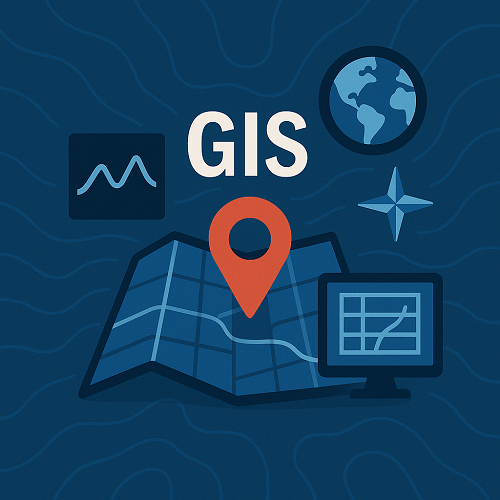TL;DR
- 3D GIS modeling and real-time analytics are transforming urban planning and infrastructure management.
- Artificial Intelligence (AI) and Internet of Things (IoT) integration accelerate predictive and automated mapping workflows.
- Open data initiatives are breaking barriers to geospatial interoperability and fostering public-private collaboration.
- Cross-sector adoption—from agriculture to disaster response—is rising due to enhanced data accessibility.
- Cloud-native GIS platforms and APIs are improving scalability and user experience.
What’s New Right Now
In 2025, the geospatial sector continues to expand at an unprecedented pace. Advanced 3D modeling and real-time analytics are now central to both public and private GIS operations. Integrations with AI and IoT systems are powering smarter, automated insights for city planners, environmental scientists, and logistics managers. According to Esri Newsroom, the ability to process massive spatial datasets in real time enables dynamic, data-informed decisions across industries.
Another key trend is the push for open geospatial data. This movement encourages transparency, collaboration, and innovation through interoperability frameworks promoted by global organizations such as the Open Geospatial Consortium (OGC). Together, these advancements signify a major leap toward a more connected geospatial ecosystem.
Why It Matters
For business leaders, GIS innovation means more accurate forecasting, efficient asset management, and reduced operational costs. Real-time geospatial intelligence supports risk mitigation in areas like logistics, insurance, and real estate. For technical professionals, the convergence of AI, IoT, and cloud infrastructure allows for continuous data ingestion and automation of complex spatial analyses.
Organizations adopting cutting-edge GIS technologies are not only improving situational awareness but also establishing competitive advantages in sustainability planning, public safety, and supply chain visibility.
Deeper Insights: How GIS Is Evolving in 2025
1. Rise of 3D and Real-Time Spatial Analytics
3D GIS environments are enabling stakeholders to visualize and analyze elevation data, city infrastructure, and underground utilities simultaneously. With real-time analytics, city managers can monitor traffic congestion, water flow, and energy usage to improve urban efficiency.
2. Artificial Intelligence and IoT Integration
The convergence of AI and IoT with GIS is a game changer. AI models trained on spatial imagery detect land-use changes or forecast environmental hazards, while IoT-connected sensors relay live positional data, feeding analytical dashboards for instant decision support. As noted by Geospatial World, this synergy significantly enhances predictive mapping capabilities.
3. Open and Cloud-First Geospatial Ecosystems
Cloud-based GIS platforms offer scalability and remote accessibility, empowering distributed teams. Open data initiatives and API-driven architectures promote integration across disciplines, reducing costs and enhancing innovation.
| Approach | Core Benefit | Typical Use Case |
|---|---|---|
| Traditional Desktop GIS | Local data management and spatial analysis | Environmental studies, mapping |
| Cloud-Native GIS | Scalability, collaboration, API integrations | Enterprise workflows, smart cities |
| AI-Enhanced GIS | Automated recognition and prediction | Disaster detection, agriculture monitoring |
| IoT-Driven GIS | Real-time spatial insights | Traffic, utilities, public safety |
Mini Case Study: Flood Response Optimization
Problem: A regional emergency authority faced delays in assessing flood impacts due to disconnected datasets and manual mapping processes.
Approach: The organization implemented a real-time GIS dashboard that integrated IoT river sensors, satellite imagery, and predictive AI models hosted on a cloud platform. This setup allowed automated updates of flood extent maps every 15 minutes.
Outcome: Decision turnaround time improved by 60%, and evacuation route planning accuracy increased by 35%. The organization’s investment in real-time GIS drastically improved situational awareness and resource allocation.
Implementation Checklist
- Assess organizational goals and identify high-value GIS use cases.
- Audit current spatial data structures and interoperability gaps.
- Choose a GIS platform with strong API and cloud support.
- Incorporate AI/IoT capabilities for automation and live monitoring.
- Train staff in advanced spatial data analytics and visualization tools.
- Establish open data and sharing policies to enhance collaboration.
- Measure outcomes against spatial performance indicators regularly.
FAQs
1. What is driving the recent surge in GIS adoption?
Increased availability of cloud resources, AI advancements, and accessible open data are fueling GIS adoption across industries.
2. How does AI improve GIS operations?
AI accelerates spatial analysis by automating map classification, detecting patterns in imagery, and producing predictive models for environmental or urban applications.
3. Are open data initiatives safe for enterprise use?
Yes, open data can be secured through controlled access and standardized metadata, fostering transparency while protecting sensitive assets.
4. Can smaller organizations benefit from GIS modernization?
Absolutely. Cloud-based GIS platforms allow smaller agencies to scale solutions affordably without maintaining heavy infrastructure.
5. What skills are essential for GIS analysts in 2025?
Analysts should master spatial data management, Python scripting, AI model integration, and real-time data visualization techniques.
Conclusion
GIS technology in 2025 is reshaping spatial intelligence landscapes across urban, environmental, and industrial domains. The synergy of AI, IoT, and open data is revolutionizing how decisions are made. To stay at the forefront of innovation, organizations should explore our GIS services and build scalable, future-ready spatial solutions.
